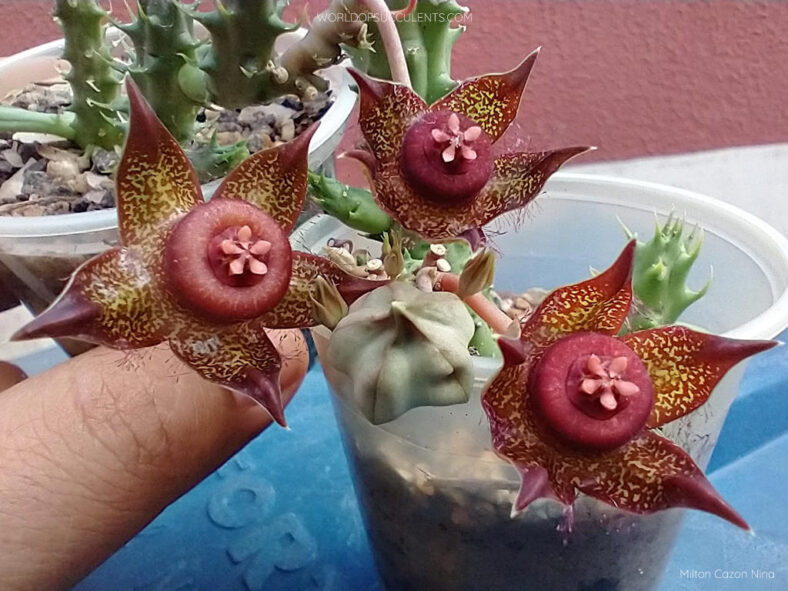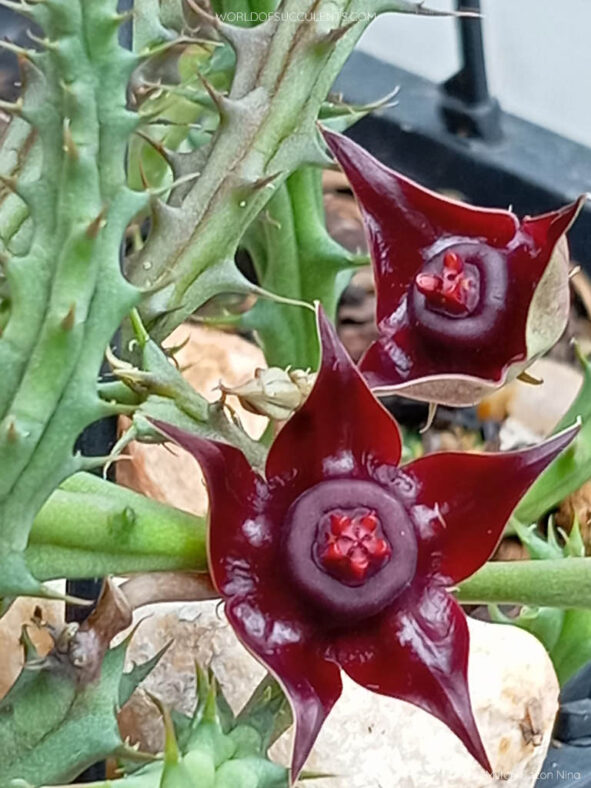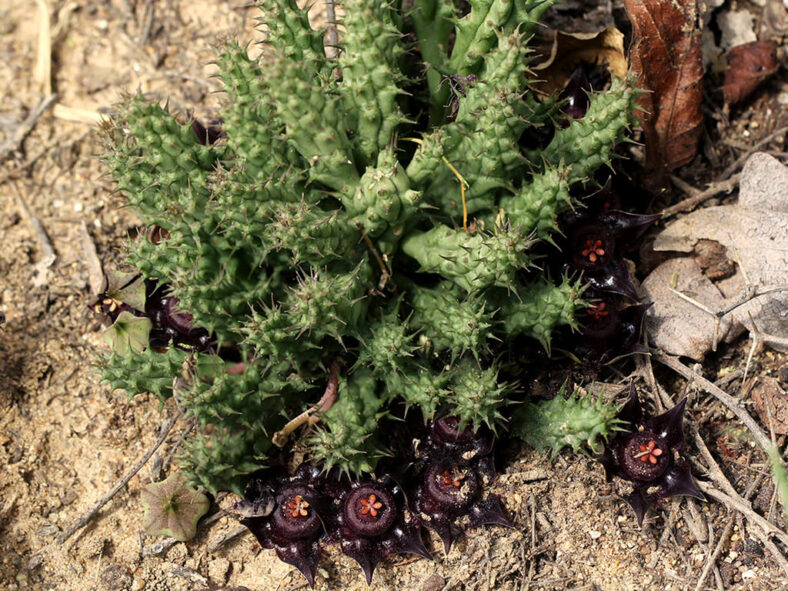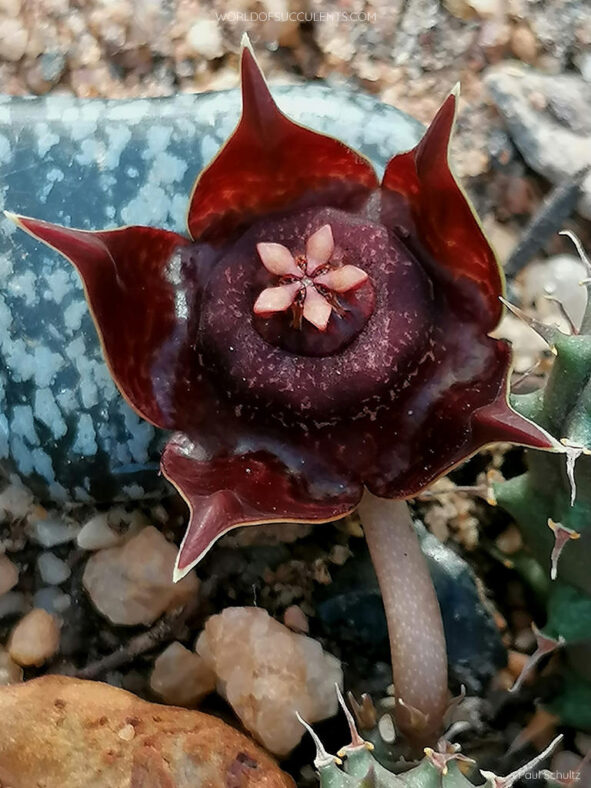Duvalia polita is one of the most widespread species of the genus Duvalia. It is a small plant that produces beautiful flowers that are highly variable in color.
Scientific Name
Duvalia polita N.E.Br.
Common Name(s)
Polished Star
Synonym(s)
Ceropegia polita
Scientific Classification
Family: Apocynaceae
Subfamily: Asclepiadoideae
Tribe: Ceropegieae
Subtribe: Stapeliinae
Genus: Duvalia
Etymology
The specific epithet "polita" (pronounced "POL-ee-tuh") means "polished, smoothed" and refers to the smooth and shiny appearance of the base of the corolla lobes of the flowers of this species.
Origin
Duvalia polita is native to several southern African countries, including Angola, Zambia, Malawi, Zimbabwe, Namibia, Botswana, Mozambique, South Africa, and Eswatini. It typically grows in dry woodlands and scrub areas, often found in sandy soils or on stony hillsides at elevations ranging from 3,280 to 5,250 feet (1,000 to 1,600 m).
Description
Duvalia polita is a small succulent that forms clumps of green to brown, cylindrical stems with conical tubercles arranged at six angles along their length. The decumbent stems can grow up to 4 inches (10 cm) long and 0.6 inches (1.5 cm) thick. The tubercles can measure up to 0.4 inches (1 cm) long and taper gradually into lance-shaped leaf rudiments subtended by stipular denticles.
From mid-summer to early fall, Duvalia polita produces attractive flowers that emerge near the base of the stems. They appear solitary or in groups of up to 4, opening in gradual succession. The corolla can reach a diameter of 1.4 inches (3.5 cm). The corolla is pale green on the outside, while the inside varies from shiny to dull reddish and dark purplish-brown, becoming paler around the center. Sometimes, the lobes are spotted with these colors on a yellow-to-cream background, with a darker purple-brown center that is not spotted. The annulus can be spotted or unspotted, covered with fine papillae, and can measure up to 0.2 inches (0.5 cm) in height and 0.5 inches (1.2 cm) in diameter. The corona is reddish-brown and can reach a diameter of 0.25 inches (0.6 cm). The fruits are paired follicles that resemble horns and can grow up to 8 inches (20 cm) long, appearing long after the flowers.

How to Grow and Care for Duvalia polita
Light: Duvalia polita prefers full sun but will benefit from light shade during the hottest summer days. Indoors, place the plant near the brightest window of your home because it will stretch if it does not receive enough sunlight. Avoid abruptly moving a plant adapted to lower light levels to full sun to prevent sunburn.
Soil: Use commercial potting soil mix for succulents or prepare your own with 50% to 70% mineral grit, such as coarse sand, pumice, or perlite.
Temperature: The plant thrives in warm outdoor environments with low to moderate humidity. It does not like winter cold and should remain fairly dry and warm during its dormancy. Duvalia polita grows best in USDA Plant Hardiness Zones 11a to 11b, with average minimum winter temperatures ranging from 40°F to 50°F (4.4°C to 10°C).
Watering: It has typical watering needs for a succulent. During the growing season, from spring to fall, water the plant thoroughly and allow the soil to dry between waterings. When it goes dormant in winter, it needs almost no water, about once a month.
Fertilizing: Fertilizing is a good idea to keep the plant healthy and thriving. Feed it with water-soluble fertilizer diluted to half the recommended strength, but only when the plant is actively growing.
Repotting: Repot Duvalia polita in spring, just before the growing season. It has shallow roots and does not require too much soil to grow. Always pick a container with drainage holes.
Propagation: The best way to propagate this succulent is by stem cuttings. To ensure good rooting, take cuttings during the growing season. The plant is also easy to start from seeds in spring.
Learn more at How to Grow and Care for Stapeliads.
Toxicity of Duvalia polita
Duvalia polita has no toxic effects reported, so it is safe for growing around kids and pets.
Links
- Back to genus Duvalia
- Succupedia: Browse succulents by Scientific Name, Common Name, Genus, Family, USDA Hardiness Zone, Origin, or cacti by Genus
Photo Gallery
Click on a photo to see a larger version.


